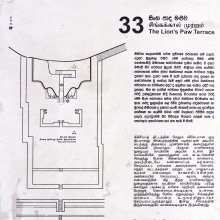Simhapada, Simha-pada, Siṃhapāda, Siṃhapada: 3 definitions
Introduction:
Simhapada means something in Hinduism, Sanskrit, the history of ancient India. If you want to know the exact meaning, history, etymology or English translation of this term then check out the descriptions on this page. Add your comment or reference to a book if you want to contribute to this summary article.
Images (photo gallery)
In Hinduism
Vastushastra (architecture)
Source: Wisdom Library: Vāstu-śāstraSiṃhapāda (सिंहपाद) refers to a type of pillar (stambha). It is a lion-based pillar. Its description is found in texts such as the Īśānaśivagurudevapaddati (verses 31.25) and Kāmikāgama (verse 53.40).
Source: OpenEdition books: Architectural terms contained in Ajitāgama and RauravāgamaSiṃhapāda (सिंहपाद) refers to “n. of a type of pillar § 3.22.”.—(For paragraphs cf. Les enseignements architecturaux de l'Ajitāgama et du Rauravāgama by Bruno Dagens)

Vastushastra (वास्तुशास्त्र, vāstuśāstra) refers to the ancient Indian science (shastra) of architecture (vastu), dealing with topics such architecture, sculpture, town-building, fort building and various other constructions. Vastu also deals with the philosophy of the architectural relation with the cosmic universe.
Chandas (prosody, study of Sanskrit metres)
Source: Journal of the University of Bombay Volume V: Apabhramsa metres (2)Siṃhapada (सिंहपद) is the name of an Apabhraṃśa metre classified as Dvipadi (metres with two lines in a stanza) discussed in books such as the Chandonuśāsana, Kavidarpaṇa, Vṛttajātisamuccaya and Svayambhūchandas.—Siṃhapada has 38 mātrās in each of their two lines, made up with 9 caturmātras and 1 dvimātra, and has the yati after the 16th and the 24th mātrās. A Siṃhapada with the yati after the 14th and the 22nd mātrās is called Dīrghaka by Hemacandra and Ratiramaṇapriya by Svayambhū.

Chandas (छन्दस्) refers to Sanskrit prosody and represents one of the six Vedangas (auxiliary disciplines belonging to the study of the Vedas). The science of prosody (chandas-shastra) focusses on the study of the poetic meters such as the commonly known twenty-six metres mentioned by Pingalas.
India history and geography
Source: Cologne Digital Sanskrit Dictionaries: Indian Epigraphical GlossarySiṃha-pāda.—cf. Tamil śiṅga-pādam (SITI), legs of a vessel or vessel-stand in the shape of lion's feet. Note: siṃha-pāda is defined in the “Indian epigraphical glossary” as it can be found on ancient inscriptions commonly written in Sanskrit, Prakrit or Dravidian languages.

The history of India traces the identification of countries, villages, towns and other regions of India, as well as mythology, zoology, royal dynasties, rulers, tribes, local festivities and traditions and regional languages. Ancient India enjoyed religious freedom and encourages the path of Dharma, a concept common to Buddhism, Hinduism, and Jainism.
See also (Relevant definitions)
Partial matches: Simha, Pada, Pata.
Query error!
Full-text: Dirghaka, Ratiramanapriya.
Relevant text
Search found 1 books and stories containing Simhapada, Simha-pada, Siṃha-pāda, Siṃha-pada, Siṃhapāda, Siṃhapada; (plurals include: Simhapadas, padas, pādas, Siṃhapādas, Siṃhapadas). You can also click to the full overview containing English textual excerpts. Below are direct links for the most relevant articles:
Isanasivagurudeva Paddhati (study) (by J. P. Prajith)
19. Description of Durga (rites and rituals) < [Chapter 4 - Worship of Gods and Goddesses]

